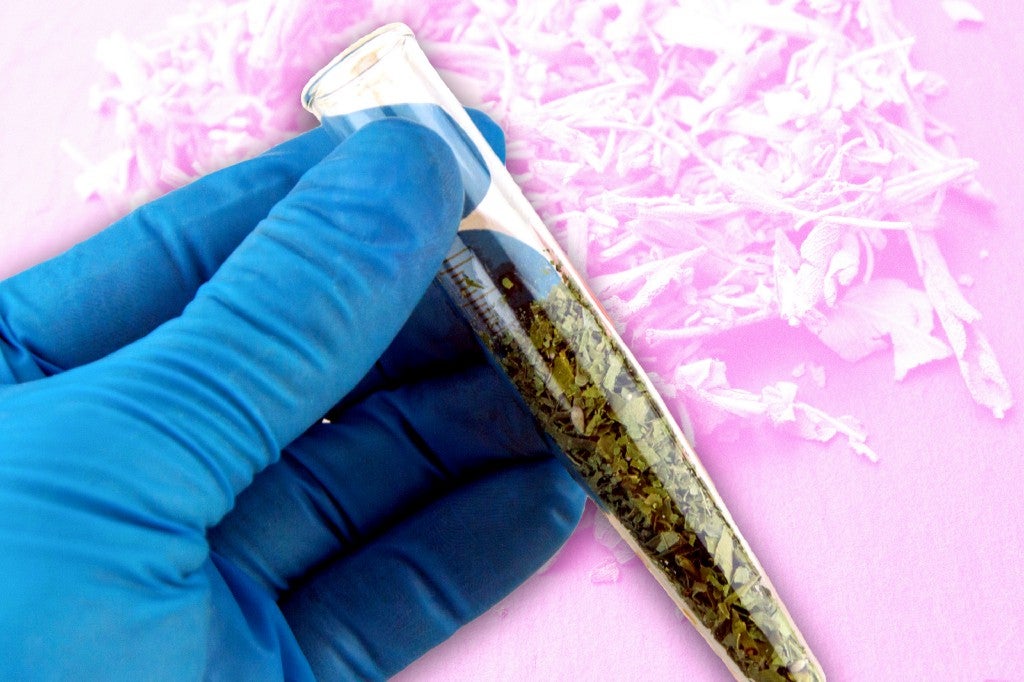Four people have died and more than 150 have fallen ill after taking synthetic cannabinoids—also known as Spice, K2 or fake weed—in the months of March and April. The symptoms reported by poison control centers—primarily those in Illinois and Maryland—include unexplained bruising and severe bleeding from the eyes, ears, mouth, nose and bowels.
“We’re warning people to not use synthetic cannabinoids,” said Bruce Anderson, executive director of the Maryland Poison Center, in a statement. “While never safe, the recent increased risk of adverse effects such as synthetic cannabinoid-associated coagulopathy makes it critical for people to abstain.”
All of which begs the question: Why would you not just smoke regular, non-bowel bleeding weed instead? And what the hell is in this stuff that makes your ass bleed, anyway?
Let’s find out.
What are synthetic cannabinoids?
Synthetic cannabinoids are mind-altering chemicals that affect the same brain receptors as THC, the active chemical in cannabis. They originate in labs—typically for academic or pharmaceutical research—and once produced, they’re later sold diffused onto shredded plants or as a liquid that can be vaporized.
“Some of these synthetic cannabinoids can be far more powerful than the THC found in marijuana,” explains Ruben Baler, health science administrator at the National Institute on Drug Abuse. While THC can activate five or six cannabinoid receptors in the brain and body, he says that synthetic cannabinoids are able to activate as many as 1,000 cannabinoid receptors. “The consequences of that are unknown.”
Because synthetic cannabinoids are usually sold as blends with fluctuating potencies, the effects can be extremely unpredictable—some users report extreme euphoria, while others report intense paranoia. An anonymous teenager recounts his traumatic experience with K2 on an online forum:
“I felt as though I was losing control of my hands and feet. They felt very far away, like they weren’t my own. I tried touching the couch, rubbing the textures, but felt nothing. My sense of touch was almost completely gone, and this really unsettled me. I couldn’t feel anything, other than a growing coldness all around me.
“It felt like my body was just failing on me, my organs were not working any further, it was just shutting down. I began to shake much like someone would during a seizure.”
Which, frankly, sounds like a panic attack, but who wants to take that risk?
The actual chemical makeup of synthetic cannabinoids is constantly changing—since producers continuously swap the compounds to evade bans. As a result, there’s also a severe lack of quality control, meaning chemicals and contaminants may vary from batch to batch.
Who uses synthetic cannabinoids, and why?
Despite the current outbreak of frightening news stories, the use of synthetic cannabinoids is largely on the downslope. According to the American Association of Poison Control Centers, poison control centers across the U.S. received 6,968 calls about synthetic cannabinoids in 2011, compared with only 1,952 in 2017. “Kids are perceiving [synthetic cannabinoids] as more and more dangerous,” Baler explains. “Plus, they have other options [like legalized pot].”
But because synthetic cannabinoids are cheap and easily accessible—you can buy a hefty bag of K2 for $5 from your local convenience store—they remain popular among poor and homeless populations. Synthetic cannabinoids are also difficult to detect through traditional drug testing, which is an attractive quality for military personnel, blue-collar workers and previously incarcerated inmates who are regularly tested (but still want to get high).
Why are synthetic cannabinoids dangerous?
Synthetic cannabinoids are dangerous for two reasons: They’re extremely potent and addictive—contributing to mental health problems, like catatonia and delirium—and they’re prone to contamination. The latter appears to be the culprit behind the most recent outbreak. An ongoing investigation found rat poison (specifically brodifacoum) in both synthetic cannabinoids and the blood of those affected, which explains the uncontrollable bleeding—brodifacoum is a lethal anticoagulant.
How brodifacoum made its way into these synthetic cannabinoids isn’t clear. Douglas Feinstein, a neuroscientist developing better treatments for brodifacoum at the University of Illinois at Chicago, mentions that some extreme drug users deliberately ingest rat poison to prolong their high. “The brodifacoum will tie up the liver; therefore, anything else you’re taking at the same time won’t break down,” he explains. “So if you’re trying to get high, the drugs will last longer.” We also can’t rule out malicious intent.
While treatments for brodifacoum currently exist, they’re far too expensive for the poor and homeless populations most attracted to synthetic cannabinoids. “They give patients vitamin K, and that keeps people alive,” Feinstein says. “But it’s crazy expensive—$1,000 per day, or more—and you have to take it for about three months.” Feinstein is currently attempting to develop methods that would reduce the treatment to two weeks.
While this is reportedly the first time that brodifacoum has been detected in synthetic cannabinoids, these human-made drugs frequently face contamination. “You never know what you’re taking, because [synthetic cannabinoids] are manufactured in unknown places,” Baler adds. “These companies don’t follow good laboratory practices.”
No shit—a phrase you sadly can’t use to describe synthetic weed.

